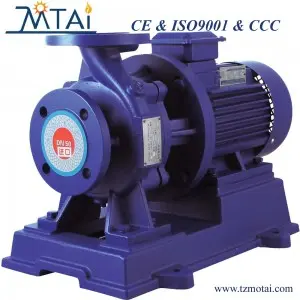Centrifugal pumps have many advantages such as wide range of performance, uniform flow, simple structure, reliable operation and convenient maintenance. Therefore, centrifugal pumps are the most widely used in industrial production. Except for reciprocating pumps that are commonly used when high pressure and small flow rates or metering are used, vortex pumps and positive displacement pumps are commonly used when liquids contain gas, and rotor pumps are commonly used for high-viscosity media, centrifugal pumps are used in most other situations.
According to statistics, in chemical production (including petrochemical) equipment, the usage of centrifugal pumps accounts for 70% to 80% of the total number of pumps.
How centrifugal pumps work
A centrifugal pump is mainly composed of an impeller, a shaft, a pump casing, a shaft seal and a sealing ring. Generally, the pump casing must be filled with liquid before starting a centrifugal pump. When the prime mover drives the pump shaft and impeller to rotate, the liquid will move in a circle with the impeller on the one hand, and on the other hand, it will be thrown from the center of the impeller to the outer periphery under the action of centrifugal force. The impeller gains pressure energy and velocity energy. When the liquid flows through the volute to the discharge port, part of the velocity energy will be converted into static pressure energy. When the liquid is thrown from the impeller, a low-pressure area is formed in the center of the impeller, forming a pressure difference with the pressure of the suction liquid surface, so the liquid is continuously sucked in and discharged at a certain pressure.
Main parts of centrifugal pump
(1)
pump casing
There are two types of pump casing: axially split type and radially split type. The casings of most single-stage pumps are of the volute type, while the radially split casings of multi-stage pumps are generally annular or circular.
Generally, the inner cavity of the volute pump casing is a spiral liquid channel, which is used to collect the liquid thrown out from the impeller and lead it to the diffusion tube to the pump outlet. The pump casing bears all the working pressure and the heat load of the liquid.
(2)
impeller
The impeller is the only power-working component, and the pump works on the liquid through the impeller. There are three impeller types: closed, open, and semi-open. The closed impeller is composed of blades, front cover and rear cover. The semi-open impeller consists of blades and a rear cover. The open impeller only has blades and no front and rear covers. Closed impellers have higher efficiency, while open impellers have lower efficiency.
(3)
sealing ring
The function of the sealing ring is to prevent internal and external leakage of the pump. The sealing ring is made of wear-resistant material and is mounted on the front and rear cover plates of the impeller and the pump casing. It can be replaced after wear.
(4)
Shafts and Bearings
One end of the pump shaft is fixed with the impeller, and the other end is equipped with a coupling. Depending on the size of the pump, rolling bearings and sliding bearings can be used as bearings.
(5)
Shaft seal
Shaft seals generally include mechanical seals and packing seals. Generally, pumps are designed to be equipped with both packing seals and mechanical seals.
Post time: Jan-23-2024









